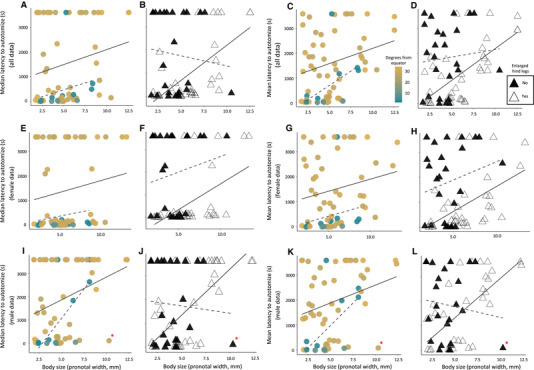Figure 2.

Species that are smaller and closer to the equator autotomize more quickly, and the degree to which having an enlarged hind femur influences the latency to autotomize is sex and size specific. Circle coloration corresponds to distance from the equator, in degrees, from which species were collected (A, C, E, G, I, and K). Because degrees from equator had a bimodal distribution (Fig. S6), we plotted linear regressions associated with each mode to help visualize the data. The solid line includes species relatively far from the equator (>25 degrees), whereas the dashed line includes species closer to the equator (<10 degrees). Note that for a given body size, species closer to the equator often autotomize more quickly. Open triangles and the corresponding solid line regressions denote presence of enlarged hind legs, whereas closed triangles and dashed line regressions correspond to the absence of enlarged hind legs (B, D, F, H, J, and L). Note that for a given body size, species with enlarged hind legs generally autotomize more quickly when analyzing the mean all data (D) and female only data (F and H). However, for the male only data (J and L), there is an interaction between body size and the presence of enlarged hind legs. This interaction is strongly driven by a single data point (Table 2; Fig. S7). Red asterisk denotes deviant data point. Untransformed autotomy data were used in this figure to aid data interpretation. Some data points overlap.
